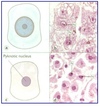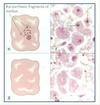Workshop 3 - Cellular injury Flashcards
Cellular injury ( lesion )
Represents all the morphological and functional changes produced in
1.cells
2.tissues
3.organs
caused by the action of different agents ( physical , chemical, biotical )
Levels of lesions ( 4 ) :
- tissular
- cellular
- subcellular
- molecular
The cellular response to pathogens depends on ( 3 ) :
- type of cells
- duration of pathogen action
- intensity of pathogen action
Cell type in relation with cell division (3)
- labile cells
- stable cells
- permanent cells
labile cells
cells with high capacity of division
ex. basal cell

stable cells
cells with **low **capacity of division
or **slow regeneration **
ex. glandular parenchyma ( liver, kindey )
* bone *
permanent cells
high specialiazed with
NO capacity of division
ex. skeletal, heart, nerve cells
Cellular injury type in relation with **intensity **of pathogen action ( 3 )
- low intensity agent
- moderate intensity agent
- severe intesity intensity
Low intensity agent
- *Acute reversible lesion **
ex. Hydropic degeneration
Moderate intensity agent
**Chronic reversible lesions **
- Adaptive reactions ( hypetrophy , hyperplasia, atrophy, involution, metaplasia )
- Intracellular accumulation ( lipides , proteins , glycogen )
Adaptive reactions
moderate-intensity agents
chronic reversible lesions
- Hypetrophy , hyperplasia
- Atrophy , Involution
- metaplasia
intracellular accumulations
moderate - intensity agent
chronic reversible lesions
- Lipids
- proteins
- glycogen
Severe - intensity agent
Leads to instant CELL DEATH
irreversible lesions : necrosis and apoptosis
Irreversible lesions ( 2 )
- necrosis
- apoptosis
Injury of a cells leads to 2 things :
- degeneration ( nonlethal )
- necrosis ( lethal )
Non lethal injury
**Cell degeneration **
Is reversible but may progress to –> *Necrosis *
* when is associated with adnormal cells fuction –> cell degeneration can cause clinical disease
Lethal injury
**NECROSIS **
biochemical and structural changes : irreversible
Types of cellular lesions
( intracellular )
- Acute reversible : hydropic degeneration
- Irreversible : necrosis , apoptosis
- Chronic reversible :
1. Adaptation of cell growth and differentiation
2. Intracellular accumulation : of lipis , proteins , glycogen
3. Intracellular accumulation of pigments
4. Injury caused by abnormalities in calcium metabolism ( *pathological calcification : *dystrophic , metastatic )
Acute reversible intracellular lesion
hydropic degeneration
Irreversible intracellular lesion
necrosis, apoptosis
Chronic reversible ( intracellular lesion ) ( 4 )
- Adaptation of cell growth and differentiation
- Intracellular accumulation : of lipis , proteins , glycogen
- Intracellular accumulation of pigments
- Injury caused by abnormalities in calcium metabolism ( pathological calcification : dystrophic , metastatic )
Types of extracellular lesions
- hyalinosis
- amyloidosis
Hydropic degeneration
( edema )
definition , cause , organs
Acute reversible cell injury
caused by various pathogens : ( anoxia , toxins, viruses )
Its the *FIRST *manifistation of all lessions that appear in almost all cell types of aggression , of LOW intensity
Ex. Hydropic degeneration of LIVER
Hydropic degeneration
pathogenesis
- alteration of Na-K pump at the level of cell membrane
- cells can no longer maintain hydro-ionic balance
- sodium ( Na ) and water ENTER the cell
- Potassium ( K ) EXITS the cell
Hydrotropic degeneration
( morphology )
**cell hyperhydration
cellular edema **
ex. parenchymal cells ( liver , kidneys etc )
Hydropic Degeneration
( macroscopically )
The affected organ is :
- increased in Volume
- **pale **
- **friable **
- ** **appearance of **boiled meat **( cloudy swelling )
Hydropic degeneration
( microscopically )
- Cell : cell ballooning, increased cell volume
- Capillaries : Compressed ( pale organ )
- Nucleus : normal, central
- Cytoplasm appearance varies :
1. fine vacuolisation ( vacuolar degeneration )
2. completely unstained ( clear degeneration )

Necrosis
( definition )
Is an irreversible cellular change
represent all nucleo-cytoplasmatic changes that follow cellular death in living tissue or organ
can :
directly
follow cell degeneration
Necrosis
processes that lead to necrosis ( 2 )
- **coagulative necrosis **
- denaturation of cytoplasm protein
- fragmentation of cell organelles
- cell swelling
- **Lysis necrosis **
cause by enzymes that are : - derived either from death cell lysosomes ( autolysis )
-immigrants neutrophil lysosomes ( heterolysis )
What means Coagulative necrosis ? ( 3 )
- denaturation of cytoplasm protein
- fragmentation of cell organelles
- cell **swelling **
What is lysis caused by ?
cause by enzymes that are :
- derived either from death cell lysosomes ( autolysis )
- immigrants neutrophil lysosomes (** heterolysis** )




























